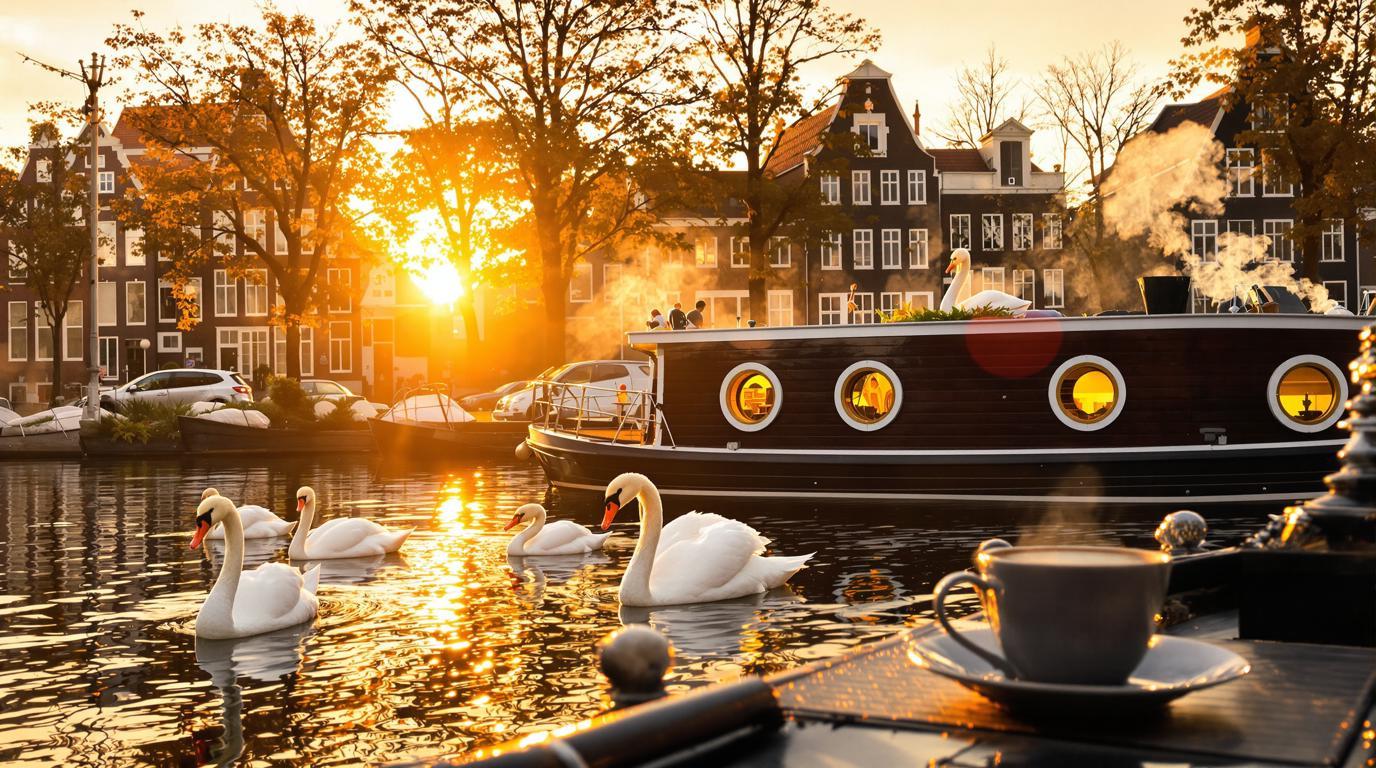I paid €60 a night to sleep on a houseboat in Amsterdam—and woke up surrounded by swans
Why I chose a floating home over traditional lodging
Amsterdam’s canal-lined streets offer plenty of accommodation options, but none quite captured my imagination like the chance to sleep directly on the water. After comparing hotel prices averaging €150+ per night, I stumbled upon a charming houseboat rental for just €60—less than half the cost of most centrally-located hotels and with infinitely more character.
“Living on Amsterdam’s canals gives you a perspective few tourists experience. You’re not just visiting the city—you become part of its rhythm,” explained my host Jan, a lifelong Amsterdammer who’s owned his floating home for over 15 years.
The swan alarm clock I never expected
Nothing prepared me for my first morning. As sunlight filtered through the porthole windows, I stepped onto the small deck with my coffee to find three elegant swans gliding silently around the boat. Their graceful movements against the backdrop of centuries-old buildings created a scene more magical than any hotel view could offer.
Unlike the noisy hostels I’d stayed in previously across Europe (like some remote European islands where accommodations are limited), the gentle rocking of the houseboat lulled me into the deepest sleep I’d had in weeks.
A floating sanctuary in the city center
Located on the Brouwersgracht canal in the historic Jordaan district, my floating home offered surprising spaciousness within its 450 square feet. The interior featured clever storage solutions, a fully-equipped kitchenette, and surprisingly good WiFi—amenities I hadn’t expected at this price point.
What truly set the experience apart was the unparalleled connection to Amsterdam itself. The soft sounds of water lapping against the hull, passing boats, and distant bicycle bells created a soundtrack uniquely Dutch.
Morning coffee with Amsterdam’s best view
Each morning, I’d brew coffee using the vintage stovetop espresso maker and sit on the small deck watching Amsterdam wake up. Canal-side windows glowed with warm light as locals commuted by bicycle. This ritual—impossible in a standard hotel room—quickly became my favorite part of each day.
The peaceful setting rivaled even the tranquility I’d experienced at Bali’s ancient temple sanctuaries, though with distinctly European charm.
Living like a local: the houseboat advantage
Beyond cost savings, the houseboat offered an authenticity impossible to replicate in commercial accommodations. My neighbors included other houseboats where actual Amsterdammers lived year-round, not tourists.
“Houseboats are embedded in our cultural heritage,” explained city historian Marieke Vos. “They represent Amsterdam’s pragmatic approach to urban living—making beautiful use of limited space while maintaining a connection to our waterways.”
Practical realities of floating accommodations
Of course, houseboat living comes with unique considerations. The bathroom, while functional, was compact. The gentle rocking might challenge those prone to motion sickness, though I found it soothing. And unlike Spain’s ancient palaces turned hotels, space was definitely at a premium.
The tradeoffs were well worth it. Watching light dance across canal waters as dusk settled over the city created memories no hotel room could match, regardless of star rating.
How to find your own Amsterdam floating home
Booking platforms like Airbnb and Booking.com offer numerous houseboat options, but I found mine through a local site specializing in canal accommodations. Prices range from €50-200 depending on size, location, and amenities.
Unlike Croatia’s natural wonders that require advance planning, houseboats remain Amsterdam’s relatively undiscovered accommodation secret. Book several months ahead for summer visits when demand peaks.
A perspective that transforms the entire experience
As my final morning arrived, I watched an elderly man in a small wooden skiff delivering fresh flowers to neighboring houseboats—a scene that felt pulled from another era, despite occurring in a major European capital.
This houseboat stay transformed Amsterdam from just another European city stop into a place I connected with deeply—similar to how visitors describe their first encounter with ancient cave paintings that change their understanding of human history.
For the price of a budget hotel room, I received something priceless: Amsterdam from a completely different angle, quiet mornings with swans, and the gentle rhythm of canal life that continues as it has for centuries.
